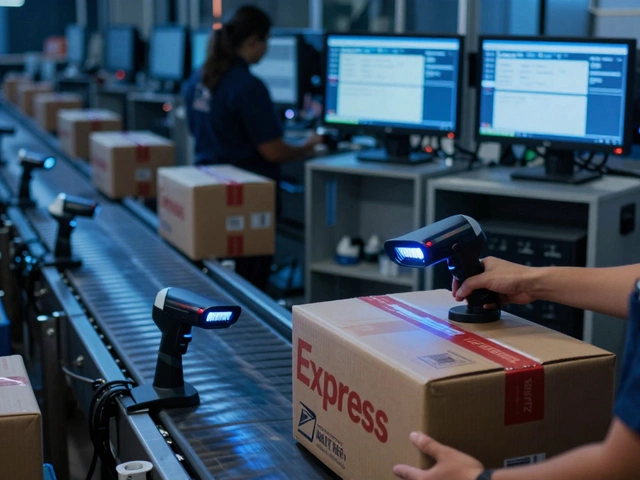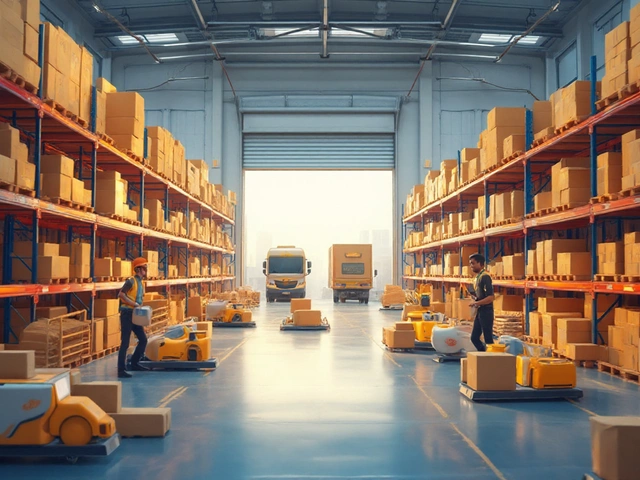Some warehouses seem to get orders out the door with barely a hiccup, even on their busiest days. It's not just luck. The warehouse management system they're using often makes all the difference. The right WMS isn't just about scanning barcodes or tracking pallets—it's about making your whole operation run smoother and faster.
If you've ever gotten swamped by paper pick lists or felt lost in a maze of shelves, you know how easy it is for things to snowball. The market's packed with different WMS options, each doing things a little differently. And not every type fits the same kind of business. You don't want to drop cash on something super advanced if all you need is a simple fix—or settle for a basic system that can't keep up as you grow.
We're about to break down the four types of warehouse management systems you’ll actually find out there. No jargon, just the facts. By the end, you'll know which system lines up with your style—and what to look out for if you want to avoid common headaches.
- Why Picking the Right WMS Matters
- Standalone WMS: Simple but Effective
- Cloud-Based WMS: Flexibility On Tap
- ERP Integrated WMS: All-in-One Powerhouse
- Supply Chain Modules: Big Picture Control
- Advice for Choosing What Fits Best
Why Picking the Right WMS Matters
Getting the right warehouse management system is huge for any business that stores or ships products. The wrong WMS isn't just an annoyance—it can cost you real money, waste your workers' time, and confuse your customers. You know those late-night headaches when orders pile up and the team can’t track down half the inventory? Most of that stress comes from using a system that just doesn’t fit your operation.
Companies using the right WMS see big changes. A 2023 study by LogisticsIQ showed that warehouses that switched from manual systems to a fit-for-purpose WMS cut picking errors by up to 70% and boosted order turnaround by 30%. These aren’t small numbers. The extra speed keeps your customers happy and keeps those online reviews from turning ugly.
If you’re stuck using spreadsheets or an old system, you’re probably missing out in ways you don’t even realize. Here’s what a good WMS can do:
- Keep your inventory on point so you’re not over-ordering or running out.
- Save you time with barcode scanning, real-time tracking, and fast reporting.
- Slash labor costs by avoiding repeat work and reducing mistakes.
- Let you scale up easily, whether it’s busy season or you’re just growing fast.
A solid WMS fits your operation and grows with you. Here’s a quick look at what businesses say after upgrading their warehouse management setup:
| WMS Impact Area | Reported Improvement |
|---|---|
| Picking errors | -70% |
| Order processing speed | +30% |
| Inventory accuracy | Up to 99% |
| Labor costs | -25% |
Here’s the simple truth: if your warehouse solutions don’t line up with your business needs, you’ll hit bottlenecks, waste money, and probably lose customers you worked so hard to get. Starting with a WMS that fits you isn’t just smart—it’s crucial to keeping your business in the game.
Cloud-Based WMS: Flexibility On Tap
Ever wish you had eyes on your warehouse when you're not physically there? That’s one big reason businesses are switching to cloud-based warehouse management systems. With cloud-based WMS, all your inventory data sits on remote servers—you just log in from your laptop, phone, or tablet from anywhere with Wi-Fi. Security isn’t a worry either; most platforms use bank-level encryption and back up everything automatically, so even if your local systems crash, your info stays safe.
One cool fact: about 70% of new WMS installs in 2024 were cloud-based, according to a recent Gartner survey. That’s not a fluke. Cloud WMS gives you real-time updates, so you always know what's happening at any location, second by second. Whether it’s a delivery delay or a peak shopping season, there’s no lag in the numbers.
What stands out about cloud-based WMS? You don’t need hefty upfront investments in servers or IT teams. Most providers offer monthly subscription models, which keeps costs predictable and usually covers ongoing updates and tech support. This means your system never gets stale. Updates and new features show up automatically, with no manual installs or business downtime.
- Easy to scale for multiple warehouses or seasonal demand spikes
- Integrates smoothly with shipping carriers, marketplaces, and ERP systems
- Supports remote work for managers and supervisors
- Mobile scanner compatibility—just download the app, and you're rolling
But it’s not all sunshine. If your Wi-Fi wobbles or your internet drops, real-time updates hit pause. And some companies feel nervous about storing sensitive data offsite, even with all the security layers.
If you’re a growing business with plans to open new locations, or you want to manage stock on the fly, cloud-based WMS makes life easier, period. You get flexibility, constant access, and the ability to add new users without IT headaches. For small to medium operations, it’s often the fastest way to bring your warehouse up to speed with how the best are doing things today.
| Feature | Cloud-Based | On-Premise |
|---|---|---|
| Initial Setup Cost | Low | High |
| Access Anywhere | Yes | No |
| Automatic Updates | Yes | No |
| Disaster Recovery | Built-In | Manual |
| Average Downtime | Under 2 Hours/Year | 6-8 Hours/Year |

ERP Integrated WMS: All-in-One Powerhouse
If you’re running a warehouse that’s already got lots of business systems in play—finance, sales, procurement—you’ve probably heard about ERP integrated warehouse management systems. These aren’t standalone apps. Instead, they’re built right into your existing enterprise resource planning (ERP) platform, like SAP, Oracle NetSuite, or Microsoft Dynamics. That means your warehouse data instantly talks to your accounting, inventory, and even HR systems. Nothing gets lost in translation.
This tight connection is the main selling point. When you scan a pallet into stock, your ERP knows about it instantly. If inventory runs low, purchase orders can get triggered on autopilot. It’s all about end-to-end visibility. A recent survey by Aberdeen Group found that companies using ERP integrated WMS improved order accuracy by 99%, and cut warehouse operating costs by an average of 18%. That’s a game-changer for busy operations.
| Benefit | How It Helps |
|---|---|
| Real-time Inventory | Updates all business units the second stock moves. |
| Easy Compliance | Keeps audit trails and regulatory records with less hassle. |
| Workflow Automation | Reduces manual data entry and repetitive tasks. |
Having everything in one place saves a mountain of headaches and reduces mistakes. “Companies gain not just efficiency in the warehouse, but full control of their whole supply chain—and that just isn’t possible with siloed systems,” says Mike O’Brien, logistics writer at Multichannel Merchant.
"The moment your WMS talks to your ERP, you’re saving time, money, and stress across every department, not just in logistics."
But let’s be real—these systems do come with a learning curve. Integration takes planning, sometimes months. And you’ll probably need an IT expert or a team to set up the workflows just right. But once it’s in place, an ERP integrated WMS means your whole business runs on the same playbook—no more mixed signals or duplicated work.
If you’re ready for full automation and your business already relies on an ERP, this is the obvious next step. You’ll be amazed how much smoother warehouse operations get when everything works from the same source of truth.
Supply Chain Modules: Big Picture Control
If you want your warehouse to play nice with the rest of your business—think sales, shipping, and suppliers—you might need more than a plain warehouse management system. That’s where supply chain modules step in. They’re basically WMS features baked right into a bigger supply chain management (SCM) platform. You end up controlling way more than just what’s going on inside your four walls.
This setup means your purchasing, inventory, transportation, and even customer orders can all “talk” to each other in real time. Companies like Oracle and SAP have gone big with this approach, letting you see everything from incoming container delays to inventory surges—all in one dashboard. According to Gartner’s 2024 report, about 42% of large distribution centers are now running their warehouse via some kind of SCM module. That number keeps climbing as businesses chase better visibility and speed.
Here’s why some operations choose supply chain modules over other warehouse solutions:
- One-Handed Operation: No more jumping between software. If a delivery is late, your WMS knows instantly, and your team can react right away.
- Real-Time Analytics: Forecasting and reporting get a major upgrade. Trends, bottlenecks, and costs become easier to spot.
- Easy Collaboration: Everyone from your sales guy to your forklift driver gets on the same page. Fewer surprises, happier customers.
- Automation Rules: You can automate stuff like reorder points and shipment scheduling across your whole supply chain, not just in the warehouse.
Keep in mind, going this route is a big deal. Supply chain modules cost more and take longer to roll out than a standalone WMS. You’ll likely need IT support for the heavy lifting, and your crew will face a steeper learning curve. But for fast-growing businesses or companies juggling multiple warehouses, the big-picture control is worth it.
| WMS Type | Best For | Main Benefit |
|---|---|---|
| Standalone WMS | Small-Medium Warehouses | Quick setup, focused tools |
| Cloud-Based WMS | Flexible Ops | Remote access, easy updates |
| ERP Integrated WMS | Mid-Large Business | Centralized operations |
| Supply Chain Module | Large, complex ops | Complete supply chain visibility |
If your headaches go beyond picking and packing, and you want to see every moving part—from your suppliers to your customer—supply chain modules bring huge value. Just be ready to invest the time and tech muscle to make it work.

Advice for Choosing What Fits Best
Picking the right warehouse management system isn't just a tech decision—it's a move that can make or break your operation. You want a WMS that grows with you, not one that collects dust because it was never quite the right fit. So, where do you start?
First, size up your business. If you deal with hundreds of orders a day and lots of moving parts, going basic is selling yourself short. On the flip side, loading up on features you won’t use just drains your budget and slows folks down. Some companies save time by checking what their top competitors use—a little snooping can actually pay off.
Here’s a simple checklist to narrow it down:
- List out your must-have features. Do you need real-time tracking? Automated inventory updates? Easy returns?
- Figure out who needs access: just warehouse staff, or sales and finance too?
- Check compatibility. Will the big fancy system play nice with your current software—especially your point-of-sale or e-commerce platform?
- Decide if you want your WMS on-site (local servers) or up in the cloud. Cloud-based options often mean less hassle for updates and scaling up.
- Think about future plans. Planning to open another location soon? You’ll want something that can handle more than one spot without a meltdown.
According to a 2023 TechTarget logistics survey, over 65% of warehouse operators who switched to cloud-based WMS said they saw better order accuracy and fewer stockouts within the first six months. Cloud systems really take the edge with remote access and quick setup, especially if your staff is spread out or you juggle sites.
| WMS Type | Best For | Common Pitfall |
|---|---|---|
| Standalone | Small, focused operations | Limited growth, poor integration |
| Cloud-Based | Scaling, remote teams | Internet downtime risk |
| ERP Integrated | Businesses needing full-suite control | Setup complexity, cost |
| Supply Chain Modules | Multiple locations, big supply chains | Steep learning curve |
Jonas Klein, logistics lead at FastTrack Supply, sums it up best:
“Don’t get distracted by shiny features—focus on what’ll actually trim waste and have everyone using it every day without throwing up their hands.”Fancy and flashy can look cool in a demo, but it’s the day-to-day grind where your choice pays off—or makes you wish you’d chosen differently.
And don’t be shy to ask for a free trial or even a short-term pilot. This lets you put real orders through the system, spot deal-breakers early, and get staff feedback before signing anything big.
The right fit isn’t always the biggest or newest thing on the block. It’s the warehouse management system that solves your headaches and doesn’t create new ones. Take your time, try before you buy, and you’ll thank yourself when things finally run as smoothly as you want.





